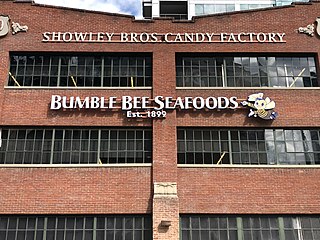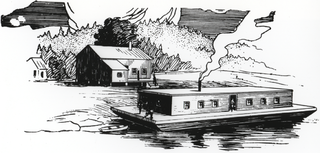This is a list of canneries. A cannery is involved in the processes of canning, a method of preserving food in which the food contents are processed and sealed in an airtight container.
This is a list of canneries. A cannery is involved in the processes of canning, a method of preserving food in which the food contents are processed and sealed in an airtight container.



The Egegik River is a waterway in the U.S. state of Alaska. A biological survey was conducted at the base of the Alaska Peninsula in 1902 by Wilfred Hudson Osgood, which included the Egegik River.

The Alaska Packers' Association (APA) was a San Francisco-based manufacturer of Alaska canned salmon founded in 1891 and sold in 1982. As the largest salmon packer in Alaska, the member canneries of APA were active in local affairs, and had considerable political influence. The Alaska Packers' Association is best known for operating the "Star Fleet," the last fleet of commercial sailing vessels on the West Coast of North America, as late as 1927.

The Kake Cannery is a historic fish processing facility near Kake, Alaska. Operated by a variety of companies between 1912 and 1977, the cannery was one of many which operated in Southeast Alaska, an area historically rich in salmon. The cannery's surviving buildings are among the best-preserved of the period, and provide a window into the labor practices of the cannery operators, which emphasized production over working conditions, and made significant use of immigrant contract workers. It was declared a National Historic Landmark in 1997.

Bumble Bee Foods, LLC, is an American company that produces canned tuna, salmon, other seafoods, and chicken under the brand names "Bumble Bee," "Wild Selections," "Beach Cliff," "Brunswick," and "Snow's." The brand is marketed as "Clover Leaf" in Canada. The company is headquartered in San Diego, California, United States. It is owned by FCF Co, Ltd. of Taiwan.

Samuel Elmore Cannery was a U.S. National Historic Landmark in Astoria, Oregon that was designated in 1966 but was delisted in 1993.
Crescent Porter Hale (1872–1937) was an American industrialist who was involved in the canned salmon industry in Bristol Bay, Alaska throughout his adult life.

John West (1809–1888) was a Scottish inventor and businessman who emigrated to Canada, California and later Oregon where he operated a cannery and exported tuna to Great Britain.

A salmon cannery is a factory that commercially cans salmon. It is a fish-processing industry that became established on the Pacific coast of North America during the 19th century, and subsequently expanded to other parts of the world that had easy access to salmon.

Canned or tinned fish are food fish which have been processed, sealed in an airtight container such as a sealed tin can, and subjected to heat. Canning is a method of preserving food, and provides a typical shelf life ranging from one to five years. They are usually opened via a can opener, but sometimes have a pull-tab so that they can be opened by hand. In the past it was common for many cans to have a key that would be turned to peel the lid of the tin off; most predominately sardines, among others.
The Marshall J. Kinney Cannery, located in Uniontown, Astoria, Oregon, United States, between Fifth and Seventh streets, was constructed in 1879 and became one of the city's longest-running salmon canneries. Run by the Astoria Packing Company, of which Marshall J. Kinney was president, the complex quickly became the "largest and most extensive salmon-packing establishment on the Pacific Coast". In 1894, the cannery was completely rebuilt after being burned to the ground. Five years later Kinney became part of the Columbia River Packers Association, joining several other canneries and packing companies. By 1904, the complex supported three production lines; Kinney continued cannery operations until the 1920s when it was primarily used as a central machine shop and warehouse for the Columbia River Packers Association. In 1954, a cargo ship ran into the complex, part of which was lost. Intact portions were used for storage until 1980 and today house shops and small businesses. The cannery was added to the National Register of Historic Places on June 30, 1989, but was delisted on September 8, 1997.

The Libby, McNeill and Libby Fruit and Vegetable Cannery was a cannery operated in Sacramento, California by Libby, McNeill, and Libby. The building is now listed on the National Register of Historic Places.

Sue H. Elmore was a steamboat built for service on the coast of Oregon and southwest Washington. From 1900 to 1917, the vessel's principal route ran from Portland, Oregon down the Columbia River to Astoria, and then west across the Columbia Bar, then south along the Oregon coast to Tillamook Bay. Once at Tillamook Bay, Sue H. Elmore was one of the few vessels that could reach Tillamook City at the extreme southern edge of the mostly very shallow bay. After this Sue H. Elmore was sold, being operated briefly in Puget Sound under the name Bergen, and then for many years, out of San Diego, California as a tugboat under the name Cuyamaca. During World War II Cuyamaca was acquired by the U.S. Army which operated the vessel as ST-361. Afterwards the army sold ST-361 and the vessel returned to civilian ownership, again under the name Cuyamaca. In 1948 Cuyamaca sank in a harbor in Venezuela, but was raised and by the early 1950s, was owned by one A. W. Smith, of Pensacola, Florida. This vessel's former landing place in Tillamook, Oregon is now a municipal park named after the ship.
W.H. Harrison was a steam schooner that operated from 1890 to 1905 on the coast of Oregon, the lower Columbia River, and southwest Washington state. At that time the salmon cannery industry was one of the major businesses of the coast. W.H. Harrison, while also carrying passengers and transporting general freight and lumber, was one of a number of steamers supplying materials to canneries along the coast, and transporting cases of canned salmon from the canneries.

The Kirkland Cannery Building, also once called King County Food Processing Plant and State Cannery Number 4, is a historic building in Kirkland, Washington. It is an 11,000 ft2 cannery, built in 1936 by President Roosevelt's Works Progress Administration (WPA), and was sold to the City of Kirkland in 1941 for $44.79. It was operated as a cooperative to benefit the poor during the Great Depression, along with three other WPA plants at Kent, Wapato, and Wenatchee. Citizens could bring in crops, fish, and chicken, to be canned at no charge in exchange for donating one third of the product to "state institutions". During World War II, it "was largely as an aid to the general food conservation program and the war effort rather than as an economic aid to the communities served". Around this time, it produced a peak of 400,000 cans of food per season. After the war it was leased to local businesspeople and used for private concerns, then sold to them in 1974. They operated the Kirkland Custom Seafood business, using the cannery building as a smokehouse for Aldercove brand smoked salmon, processing 350,000 pounds of salmon there in 2000, the year before it closed.

The steamship General Frisbie was a wooden two-deck passenger ship built in 1900, named after John B. Frisbie. She was designed for use as a ferry between Vallejo and San Francisco. The steamer was successful in that role and was the fastest ship on the route when she began service. Improved roads, bridges, and automobiles reduced demand for ferry service in the Bay Area, and newer ships were optimized for transporting cars, so General Frisbie was retired in the late 1920s.
Sacramento, California, United States, has been an important location in the history of canning thanks to its situation on the intersection of major transportation routes and proximity to large fertile growing areas. Sacramento’s canning industry has prepared a large variety of agricultural products, but is best known for canned tomatoes, earning Sacramento the nickname, "The Big Tomato."
Nikola Bezmalinovic, known as Nick Bez was founder of fishing, canning, and shipping companies in Juneau, Alaska. Nick Bez operated the largest fishing ship at the time the 423-foot, Pacific Explorer. Nick Bez also owned and operated the Nornek cannery, two gold mines, Alaska Southern Packing Company, Peter Pan Seafoods, Alaska Southern Airways, Pacific Exploration Company and the Intercoastal Packing Company as well as West Coast Airlines which became part of Air West. Nick Bez became known as a rags to riches entrepreneur. In 1919 Nikola Bezmalinovic changed his name to Nick Bez. Nick Bez died in 1969.

Hapgood-Hume Company was a Salmon cannery and now a historical site in West Sacramento, California in Yolo County. The site of the former Hapgood-Hume Company is a California Historical Landmark No. 1040 listed on April 1, 2009. The Hapgood-Hume Company was the First Pacific Coast Salmon Cannery founded on April 1, 1864, on the Sacramento River, closed in 1873 in Washington state. The site of the Hapgood-Hume Company was a National Register of Historic Places, #66000938, from April 6, 1964, to July 14, 2004. The Hapgood-Hume Company was formed by Robert Deniston Hume, William Hume, John Hume, and George Hume, with a friend Andrew Hapgood. All of founders of the company came from Maine. Hapgood had been a tinsmith and a fisherman in Maine, arriving in California in 1864.